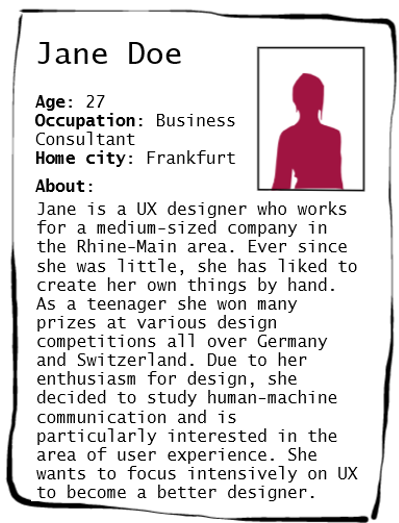# Personas
- Purpose
- Specification of usage requirements
- Time required
- 0,5 - 1 man-days per user group
- Participants
- User Researcher, UX Team
- Level of experience
- experienced

# Summary
Personas are a possibility to model and document the collected knowledge about the users of the application and to communicate it to the project members. A persona represents a user group and is presented in the form of a profile. However, it is not a real existing person, but the representative for a user group with its goals and motivations, its abilities and limitations. Personas are not completely fictional, but are based on the data collected during analysis and could, therefore, exist in reality. In order to describe a credible "person", only a few additional details may be invented (e.g. name and appearance).
# Result
Personas are used to personify the needs of the interest groups. This provides a comprehensible illustration of the user perspective which creates a basis for deriving usage requirements. This helps the team to gain empathy and a better understanding of the users.
# Approach
- Collect real information about users and other stakeholders. Conduct interviews, shadow users or gather information using ethnography.
- Divide the interviewees into individual groups. It is important that users in a user group share similar characteristics as much as possible.
- Create personas according to the groups and avoid stereotypes. Information relevant to the system being developed should also be included (e.g., motivation, goals, pain points).
- Give your personas a name and add a portrait photo.
# Time of use
Personas should be created when the context or users are not sufficiently known. It is necessary to collect (unstructured) information about the interest groups in advance.
# Tools and Templates
- Information from interviews and other research
- Pictures of strangers
- Creation with paper/pencil or with a computer (Word processing program) possible.
- Life-size displays of the persona can serve as a daily reminder of the user's perspective.
# Advantages
Personas serve the entire team during the entire project to clarify the user perspective. Personas are easy to understand, tangible and easily remembered.
# Disadvantages
Inaccurate or inappropriate information can lead to wrong decisions.
# Hints
Pay attention to ensure that each persona represents the selected stakeholder group as comprehensively as possible. Qualities should not duplicate and each persona should be completely unique. Nevertheless, personas never represent the complete reality, so don't forget the real users
# Sources
- Beck, A., (2004) Personas in der Softwareentwicklung (German) (opens new window) In: Hassenzahl, M. & Peissner, M. (Hrsg.), Tagungsband UP04. Stuttgart: Fraunhofer Verlag. (S. 104-107)
- Cooper, A., Reimann, R., Cronin, D., Noessel, C. (2014) About Face: The Essentials of Interaction Design (opens new window) 4. Aufl. Chichester, England: John Wiley & Sons Ltd
- Pruitt, J., Grudin, J. (2003) Personas: practice and theory (opens new window) In: Proceeding DUX '03 Proceedings of the 2003 conference on Designing for user experiences, S. 1-15
- Persona - Methodenkarte des Mittelstand 4.0-Kompetenzzentrum Usability (German) (opens new window)
- Personas - SimplyUsable Methoden-Baukasten (German) (opens new window)